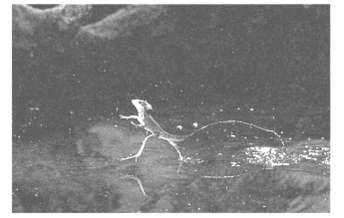Basilisk lizards can run across the top of a water surface (Figure). With each step, a hzard
Question:
Basilisk lizards can run across the top of a water surface (Figure). With each step, a hzard first slaps its foot against the water and then pushes it down into the water rapidly enough to form an air cavity around the top of the foot. To avoid having to pull the foot back up against water drag in order to complete the step, the hzard withdraws the foot before water can flow into the air cavity. If the lizard is not to sink, the average upward impulse on the hzard during this full action of slap, downward push, and withdrawal must match the downward impulse due to the gravitational force. Suppose the mass of a basilisk lizard is 90.0 g, the mass of each foot is 3.00 g, the speed of a foot as it slaps the water is 1.50 m/s, and the time for a single step is 0.600 s.(a) What is the magnitude of the impulse on the hzard during the slap? (Assume this impulse is directly upward.)(b) During the 0.600 s duration of a step, what is the downward impulse on the lizard due to the gravitational force?(c) Which action, the slap or the push, provides the primary support for the hzard,or are they approximately equal in their support?
Step by Step Answer:

Fundamentals of Physics
ISBN: 978-0471758013
8th Extended edition
Authors: Jearl Walker, Halliday Resnick





